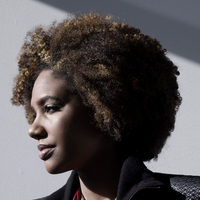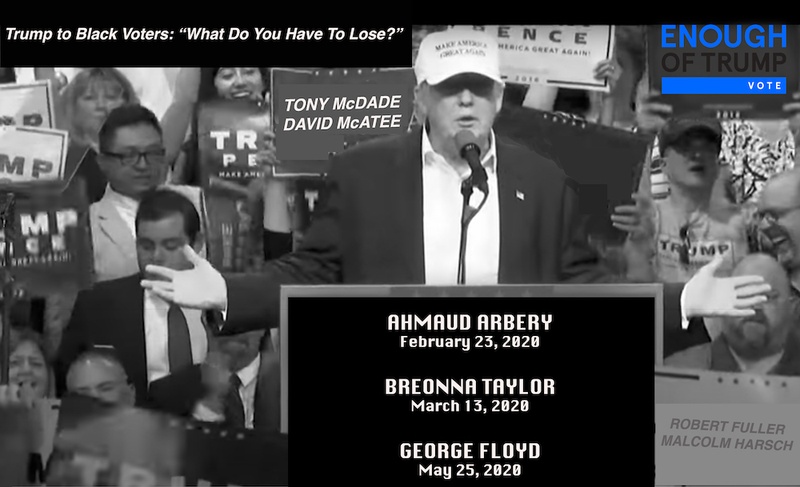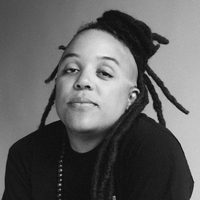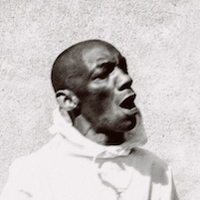As told to Daniel Sharp, 2420 words.
Tags: Art, Activism, Photography, Inspiration, Independence, Politics, Process, Collaboration, Identity.
On working with dignity
Visual artist LaToya Ruby Frazier on the value of photography, the billboards she made for the ENOUGH of Trump campaign, the collaborative process of photographing Breonna Taylor's family, and why art is intrinsically political.Two pieces you made for the Enough of Trump Campaign will go up as billboards in swing states before the 2020 election. One of them pairs COVID-19 with air pollution. Another is a picture of Donald Trump with superimposed names of Black bodies murdered by the police. Can we go through these and describe what we’re looking at?
My artistic practice—and personal life—is focused on environmental justice issues, healthcare, and equity. I can’t avoid my own background and where I come from. We know that the industrial Heartland of America plays a significant role in our elections. I will never get over the fact that Hillary had that election stolen from her. And part of the reason had everything to do with States like my home state, Pennsylvania. It had everything to do with the arrogance of that campaign to decide not to come and speak to working-class Americans, not to come to speak in the Rust Belt, not to speak to blue collar workers.
I wake up everyday thinking about Black people being murdered by the State. We live in a police state. We are constantly under siege. And in addition to being under siege in this very visible way of being gunned down or placed in a chokehold or a knee on the neck, there’s a slow violence of pollution and toxicity that are invisible silent killers surrounding Black bodies.
We are biological creatures, organisms, connected to our environment. For multiple generations we’ve been redlined to sacrifice zones contaminated by industrial and fossil fuel corporations. The United States Steel Corporation has broken many of the EPA regulations that have been put in place, and the Trump administration had the audacity to allow them to release more chemical emissions. Compound that with the COVID virus, it is inhumane.
LaToya Ruby Frazier, COVID-19 + Air Pollution, Enough Campaign, 2020.
When we talk about America, Andrew Carnegie, and industrial prosperity, we must remember that his first factory, The Edgar Thomson Steel Works, depicted here in the billboard runs along the ancient Monongahela river. This is native Indigenous land. This is the same site where the Battle of the Monongahela was fought in 1755. This land where this industrial polluter is located is already sitting on massacres and bloodshed and we keep failing to see that. For me, my photographs are like an excavation. They’re a visual archeological dig that I’m trying to put up and show people that all of this permeates within us.
I think a lot about the difficulty of discussing environmental racism because it doesn’t get headlines and gets sidelined. It’s only over time that you see these anti-environmental policies build up until you realize your river is polluted, right?
Yeah, and it’s so polluted, and then your governor denies democracy, vetoes your vote, and the next thing you know you’ve got lead contaminated water with Legionella bacteria inside of it coming into your homes and going into the mouth of your children, right? So this is serious. And it must be visualized.
Like on a billboard.
Right. It has to be put up large for people in these particular states to see that this is your choice. This is why you must act. Imagine, you’re in your car, sitting in traffic, polluting the air with your fossil fuel vehicles; nonetheless, you are in your car in traffic. Most people like to drive to clear their mind. If they see this billboard and if they see this connection—especially if they have lost a loved one who has given up their health to work in steel mills and coal mining and fossil fuel companies—if they see this, it should move them to act. I fundamentally believe that is the role of an artist, especially when we are facing a crisis like this.
I have a lot of late-millennial friends who feel disillusioned by the Democratic Party, including myself. But you’re right that this cannot be a tit for tat. This is a life or death.
I had never photographed a politician in my life. Never wanted to. But when the opportunity came to photograph Stacey Abrams, I made room in my overbooked schedule to go photograph her. I believe in this woman, her vision, what she’s been called for, the fact that she’s fighting for fair voting. The fact that she is carrying on that legacy, that so many people died for just so we could vote. We have to get back to these fundamental core values that have been removed from us because of white supremacy, fascism, and a blatant disregard for humanity and human life. This is our dignity and soul at stake—but let’s not get it twisted. After I proudly vote for the Democratic Party, I will be writing letters and protesting Biden and Harris if they don’t do right by the poor, and the working people of this country.
LaToya Ruby Frazier, The Black Vote, Enough Campaign, 2020.
You recently photographed Breonna Taylor’s family. Was that the first time meeting them? What was it like?
This was a real communal collaboration. We were celebrating Breonna’s life by making her visible through capturing her spirit through her surviving relatives. Imagine seeing me with my equipment, with the Taylor family, and all her friends holding the reflectors for me, two of them. And then all her little cousins, beautiful young men, standing there watching this, and witnessing this. The whole community was watching us make these portraits. And it was just beautiful to do this.
On Tuesday June 30, 2020 from 1 p.m. to 6 p.m. Breonna Taylor’s mother, sister and aunt, Tamika, Juniyah and Bianca, along with family and friends created a procession of photographs with me from Breonna’s apartment on Springfield Drive in Louisville Kentucky all the way to the Breonna Taylor Memorial in Jefferson Square Park. They were all so very patient, generous, kind, thoughtful, and loving about how we went about making the portraits together. There was an unspoken power of love as we purposefully made each portrait, all the way down to the details of what they wore and even when Breonna’s boyfriend Kenneth Walker proudly showed me his engagement ring for Breonna, which I requested to photograph. It was a true challenge to create portraits of a precious and meaningful life that was stolen from us to soon, and Breonna’s courageous family made it very accessible.
I can’t stop thinking about Breonna Taylor, her murder and unjust criminalization made me so upset that I risked my life and broke quarantine, knowing I am highly susceptible to COVID-19 due to having Lupus, an autoimmune disorder. This is how much it meant to me to reclaim a visual justice and humane dignified representations of Breonna and her family members.
My mother was a nurse, my niece is an aspiring nurse, Breonna Taylor wanted to be a nurse, not a piece of legislation or another slain statistic at the hands of law enforcement in America. Since Breonna worked as an EMT this would mean that the LMPD are her colleagues. To be brutally murdered at home, in the middle of the night, by the very people you work with within your community is the most offensive and heinous crime against humanity. If you look up the very definition of the characteristics and attributes of an EMT worker or a nurse, it provides the proof and evidence of Breonna’s character.
My portraits are a call for justice and the unwavering steadfast endurance of Black women in America regardless of the persecution we face on a daily basis. Breonna Taylor is a hero, a frontline essential worker, and I demand justice now. Lastly, the way the LMPD portrayed her loving boyfriend and fiancé Kenneth Walker was inexcusable. These portraits serve to restore Kenneth’s humanity and to honor his love for Breonna, as he was about to propose to her. It is abundantly clear that as time goes on and more details are revealed and there are still no arrests of the police officers and detective that murdered Breonna, that in America Black people have no constitutional rights, and therefore all lives can’t matter until Black Lives Matter!
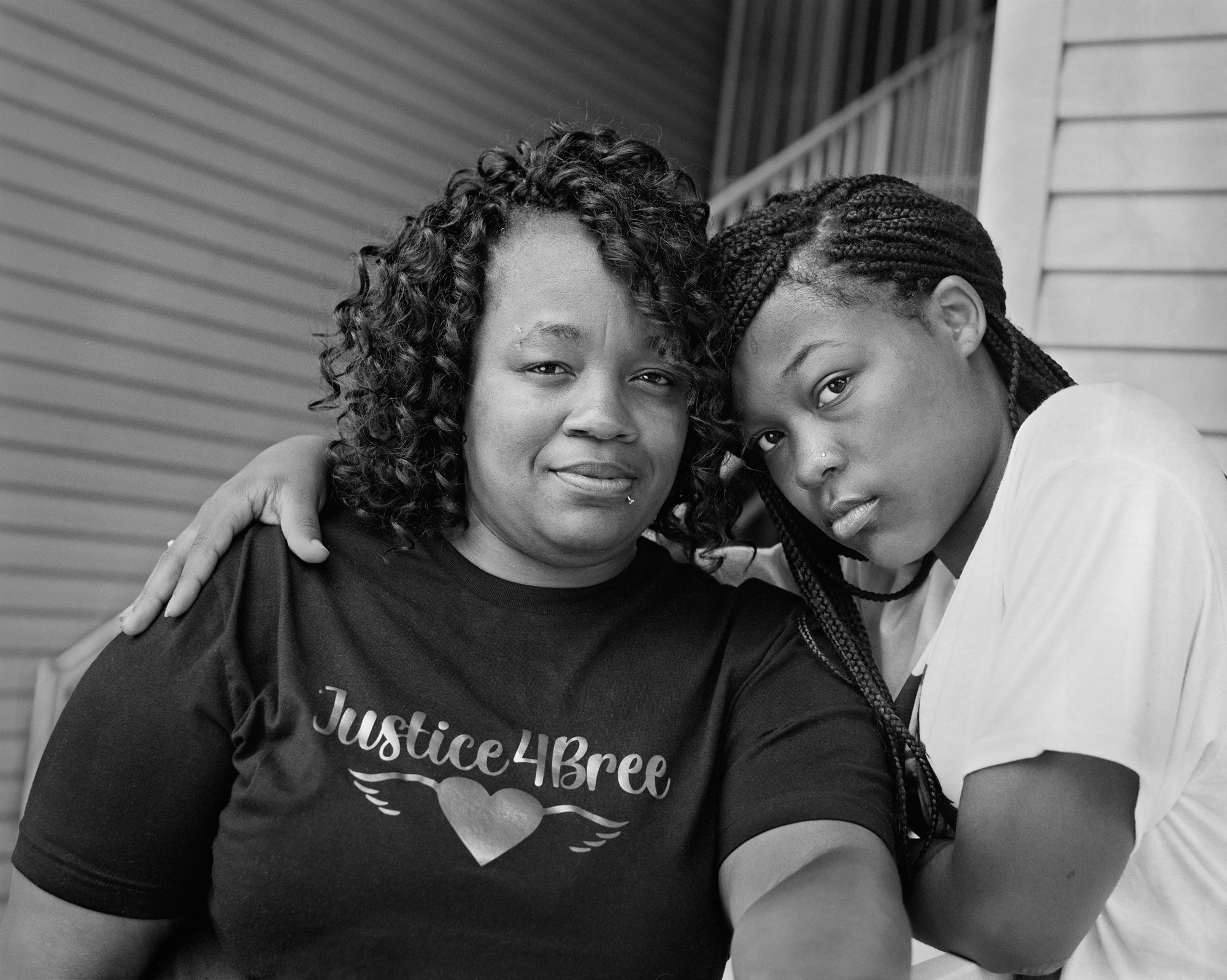 Breonna Taylor’s Mother, Tamika Palmer, and Sister, Juniyah Palmer, Standing at the Banister Where Breonna Once Stood, Near the Front Steps of Her Apartment on Springfield Drive in Louisville, Kentucky.
Breonna Taylor’s Mother, Tamika Palmer, and Sister, Juniyah Palmer, Standing at the Banister Where Breonna Once Stood, Near the Front Steps of Her Apartment on Springfield Drive in Louisville, Kentucky.
 Breonna Taylor’s Mother, Tamika Palmer, Draped in Bre’s EMT Jacket, Surrounded by Bre’s Cousin, Sister, and Aunt, Jakiyah Austin, Juniyah Palmer, and Bianca Austin, Surrounded by Close Family Friends, Deon Ellis, Jenna Winn, and Tylan Livingston, in Front of a Mural Dedicated to Breonna by Artist Damon Thompson at 543 South Shelby Street, Louisville, Kentucky.
Breonna Taylor’s Mother, Tamika Palmer, Draped in Bre’s EMT Jacket, Surrounded by Bre’s Cousin, Sister, and Aunt, Jakiyah Austin, Juniyah Palmer, and Bianca Austin, Surrounded by Close Family Friends, Deon Ellis, Jenna Winn, and Tylan Livingston, in Front of a Mural Dedicated to Breonna by Artist Damon Thompson at 543 South Shelby Street, Louisville, Kentucky.
Why would someone want to disconnect photography and politics? Why would someone say, “No, it’s art. It can’t be political?”
Art is intrinsically political. Look no further than the documentary photographers of The Photo League in New York City who were blacklisted for depicting their community and life by the Attorney General in 1947, or ask yourself why would Nazis confiscate the photographic book by artist August Sander, People of the Twentieth Century and destroy hundreds of his negatives. If you still don’t believe art is political than why would the McCarthy era target artists, photographers, and filmmakers and use propagandized slogans such as, “Beware of artists they mix with all classes of society and are therefore the most dangerous,” a slogan that was borrowed from King Leopold I, the father of King Leopold II who massacred over 10 million Congolese in Africa. We must not trivialize how artists play a vital role in documenting, commemorating, and preserving humanity in our society. In the words of James Baldwin’s essay, “The Creative Process,” 1962:
The artist is distinguished from all other responsible actors in society—the politicians, legislators, educators, and scientists—by the fact that he is his own test tube, his own laboratory, working according to very rigorous rules, however unstated these may be, and cannot allow any consideration to supersede his responsibility to reveal all that he can possibly discover concerning the mystery of the human being…. Society must accept some things as real; but he must always know that visible reality hides a deeper one, and that all our action and achievement rest on things unseen. A society must assume that it is stable, but the artist must know, and he must let us know, that there is nothing stable under heaven. One cannot possibly build a school, teach a child, or drive a car without taking some things for granted. The artist cannot and must not take anything for granted, but must drive to the heart of every answer and expose the question the answer hides...We are the strongest nation in the Western world, but this is not for the reasons that we think. It is because we have an opportunity that no other nation has in moving beyond the Old World concepts of race and class and caste, to create, finally, what we must have had in mind when we first began speaking of the New World. But the price of this is a long look backward when we came and an unflinching assessment of the record. For an artist, the record of that journey is most clearly revealed in the personalities of the people the journey produced. Societies never know it, but the war of an artist with his society is a lover’s war, and he does, at his best, what lovers do, which is to reveal the beloved to himself and, with that revelation, to make freedom real.
I sometimes face this question outside of an art context. For example, when I was talking to my mother about the prison industrial complex, and describing the horrors to her, at some point, she just kind of says, “No, no.” She didn’t want to listen or see. Of course, a week later after they watched Ava Duvernay’s 13th, my parents did the work, and now she sees it clearly. But it’s like, what about the people who never look? It’s like that reality won’t exist for them.
People have the privilege to look away so they don’t have to correct the mistakes they benefit from. They need to be held accountable and check themselves. So you must look. When people look away they deny other people their humanity, they deny people their democracy, they deny people their constitutional rights. You have to learn what it means to have a selfless love and a care for humanity. Even the people who are mad it’s not Bernie, they have to stand down. They must vote because they’re voting on behalf of someone else who is afraid, you’re voting on behalf of someone else who is going to be disenfranchised, you’re voting because someone won’t make it to the polls. You’re voting because someone has no right to vote. Ask yourself is it better to be remembered for the people you served, or is it better to only be remembered for what you did for yourself?
LaToya Ruby Fraizer recommends:
5 policies to look at closely
Universal healthcare: the Affordable Care Act hasn’t done what we really asked, in comparison to universal health care. What is it that Biden agreed to actually do here?
AOC’s Green New Deal. What does the Green New Deal mean to you? What did she write in The Green New Deal that could be supported and pushed?
Police. Taking a closer look at how all States actually fund the police.
What has the Secretary of Education Betsy DeVos done to our education system? She has single-handedly put the nail in the coffin for public school education in America. What do we need to rebuild?
Trump’s coronavirus vaccine, Operation Warp Speed. You think we’re all going to take that vaccine? Look at the insurance companies, the pharmaceutical companies, and the stock market. Look at that vaccine and how it’s going to be disseminated and hold the government responsible for it.

